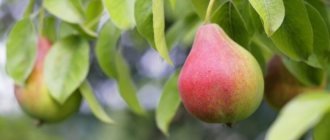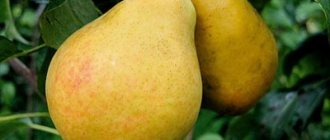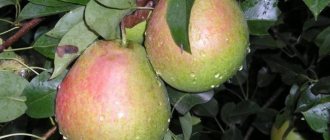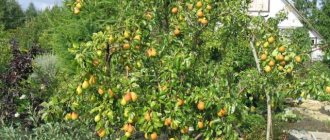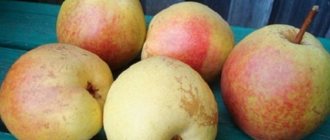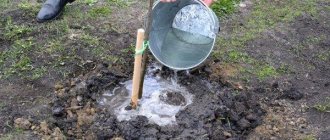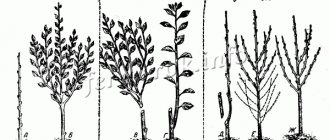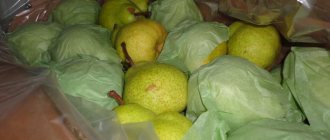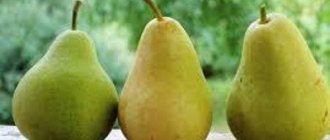Description of the Bere pear variety
Bere is a whole family of pears, which includes a wide variety of pear varieties. Their main difference is the elongated, pear-shaped shape of the fruit. From French the word "beurre" is translated as "butter". This name was not given by chance, because pear flesh is always juicy and oily in consistency.
Bere pear variety photo
The distribution area of Bera pears is predominantly Europe. For rapid growth, they need a lot of heat, so they are mostly bred in the southern regions, although these species can also be found in the middle regions. But in the northern parts of Europe, Bere is very rarely grown, because they ripen poorly and do not have such a sweet, rich taste.
Trees of the Bere variety are usually vigorous. They have a high crown in the shape of a pyramid, which can be slightly asymmetrical, especially if not corrected. The trunk and large shoots are usually very thick, the bark is gray or with a gray tint. The leaves are oval and large. Flowering occurs quite late, so the flowers usually never freeze during the return spring frosts.
Pests and diseases
Most Bere pear varieties are susceptible to fungal diseases, in particular scab, as well as various pests. To avoid this, you must adhere to the following recommendations:
- Regularly inspect the plant for possible signs of damage.
- The first preventive spraying should be carried out before the buds open, the second - during the flowering period of the tree, the last - 2 - 3 weeks before harvesting the fruits.
- If affected areas are found on the Bere pear, they should be thoroughly cleaned and the cut parts should be burned.
- Fallen leaves in autumn should absolutely not be left under the tree. It is better to bury them in the ground to ensure the death of pests nesting in them.
- In the fall, immediately after the leaves fall, the trees should be thoroughly treated with whitewash with the addition of fungicides.
Bere Summer
Also check out these articles
- How to trap a swarm of bees and transplant them into a hive
- What not to feed rabbits
- How to get rid of rats in a chicken coop?
- Keeping guinea fowl at home
Summer Bere varieties bear fruit from the end of July and throughout August. Grown primarily for sale or fresh consumption. One of the most popular summer varieties is Bere Letnaya. Its main difference is in the fruits. They are large, elongated pear-shaped and can weigh up to 280 g, while the same summer “Giffard” and “Zolotaya” produce fruits of 80-100 g maximum. The peel is always thin, smooth, yellowish with dots over the entire surface. The pulp is light, tender and sweet in taste, with a high juice content.
Bere Bosc variety is a very famous pear
Important!
Summer Bera pear varieties are soft and susceptible to shedding after full ripening, so they are harvested without delay or a few days before full ripening. They are suitable for food even at the stage of technical maturity.
Bere Letnyaya was first discovered in the Vinnitsa region. The tree begins to bear fruit already 4-5 years after planting. The variety is frost-resistant, so it can be grown not only in the southern but also in the middle regions. A 15-year-old tree can produce yields of 120 kg per year. Pears ripen around August, but it is recommended to remove them 7-10 days before ripening so that they are not yet very soft, this way they will be better stored.
Also in the summer, such types of Bere as “Clapp’s Favorite”, “Bere Giffard”, “Bere Golden” ripen.
Trees are pollinators
To increase the yield and improve the taste characteristics of the fruit, it is advisable to plant other varieties of pears near Bere Moskovskaya. Better pollinator options are:
- Chizhovskaya;
- Yuryevskaya;
- Rogneda;
- Firefly;
- Autumn sweet;
- Forest beauty.
Chizhovskaya
Firefly
Forest beauty
You can also choose any other variety. The most important thing is that the flowering dates coincide.
Bere Bosc pear variety
Autumn varieties are harvested from September to early October. The fruits rarely fall off, unlike summer varieties. The harvested crop is usually left to ripen for several weeks. During this time, they gain even more juice and sweetness and are then ready for consumption. The shelf life of such pears is 45-70 days, depending on the variety and conditions.
The variety is characterized by high productivity
The Bere Bosc variety is a very famous pear. The tree grows quickly and can expand significantly. It bears fruit late - from 6-8 years after planting. The yield of a 16-year-old tree is about 150 kg. The fruits are large, weighing 180 g, and record holders can reach 250 g. The shape of pears is oblong and uneven. The peel is thin, rusty in color after full ripening (during storage they become golden-bronze), rough to the touch.
Important!
Autumn varieties of Bere pears do not tolerate frost well, so it is recommended to grow them only in the southern regions.
Bere Bosc is one of the least frost-resistant varieties. It can only be grown in warm climates. In the northern and even middle regions, not only the above-ground part of the tree, but also the underground part of the tree can completely freeze out in one frosty winter. The drought resistance of the variety is also low. Regular watering in this case can literally save the tree in a dry summer.
The collected fruits of Bere Bosk can be stored for quite a long time, but in refrigerated chambers, during long-term storage the taste can deteriorate, so it is advisable to sell or consume them within 1-1.5 months after collection.
The advantages of the variety include ease of care and the ability to grow on light, sandy soil. It is also worth noting that the taste of the fruit is rated 4.8 out of 5! This is a very tasty variety that can be used for fresh consumption or processing.
Autumn Bere pears also include Bere Durando, Bere Moskovskaya, Bere Luca, Bere Krasnokutskaya, Bere Klerzho.
Kinds
Bere pears have more than a dozen varieties. And they all differ in their characteristic features: ripening period, visual appearance, early ripening, resistance to frost and disease. The following are the most famous and popular varieties.
Pear Bere Ardanpon
Pear is a winter variety. It was developed in Belgium in the 18th century. The plant received the same name of its discoverer. The tree is tall. The crown is dense, pyramidal in shape. The fruits are large, bell-pear-shaped with irregularities. Weight 200-250 g. The pulp is white, sweet, astringent. The amount of sugar is 10.2%. The skin is light yellow, green with brown spots. The fruits have a shelf life and can be stored for up to 4 months without loss of taste. The description clearly states that the Bere Ardanpont pear variety can only be grown in warm regions. Fruits well in the territory of Southern Crimea. The species is susceptible to scab.
Pear Bere Gardi
The Bere pear variety is of French origin. The tree is tall and strong. The crown is cone-shaped, widened towards the apex, highly branched. Branches growing horizontally, hanging down. Fruit weight 150-200 g. The pulp is cream-colored, juicy, sweet and sour, with a noticeable spicy aroma. The peel is dense, dry, yellow in color with brown or red spots on the sunny side.
The Bere Gardi pear is undemanding to planting conditions. Fruiting occurs in September.
Pear Bere Yellow
A hybrid of Russian origin, adapted for the conditions of the northern regions. In gardening catalogs it is found under the name “Berezhenaya”. The trees are low and medium-sized. The crown is rounded. The foliage is light green, the surface is matte, the edges are jagged. Small flowers are collected in inflorescences. Fruit weight is 100 g. The shape of the pears is correct, the surface is smooth. The color of the skin is light yellow, there is no blush. The pulp has a delicate consistency. Lots of juice. The seeds are large and dark in color. The fruit tastes sweet and sour. The sugar content in the pulp is 11.2%. Transportability is good. The fruits ripen at the end of September.
Pear Bere Giffard
This variety appeared in France in 1810 from seeds of unknown origin. A tree up to 5 m high. As the tree matures, growth slows down, but productivity and winter hardiness increase.
The branches are thin, reddish in color. The leaves are large, light green in color. When ripe, the fruits form the correct shape. The surface is smooth, with brown inclusions. The pulp is juicy, melts in the mouth, sweet with sourness. Pears ripen at the end of September. Fruiting is weak. Fruit weight is 50-100 g. When ripe, it is stored for 3-5 days. Afraid of frost. Bere Giffard pear is resistant to fungal diseases.
Pear Bere Golden
Bere Zolotaya pear is a summer variety from the folk selection of Belarus. The height of the trees reaches 3 m. The crown is very thick and therefore requires regular thinning pruning. Fruiting of the Bere Golden Pear occurs at the age of 5-6 years. The fruits ripen in August. The yield is plentiful. Once ripe, pears can be stored for 7-10 days. The variety is highly resistant to bacterial cancer and scab.
Pear Bere Klerzho
The Bere Klerzho pear came to Russia from Western Europe. The variety is named after the originator. A tree of medium height with a narrow pyramidal crown. The leaves are small, tapering to the tip. The fruits are dense, with a pleasant taste and aroma. The fruits ripen in early September. They should be picked immediately, otherwise they will crumble and lose their taste. The Bere Klerzho pear begins to bear fruit at the age of 4-5 years. In cold regions, the tree requires shelter.
Pear Bere Krasnokutskaya
The fruit tree is medium in height. Forms a cone-shaped, rounded shape. Regular pruning removes annual growth. Large pears, weighing 200-250 g. The shape of the fruit is elongated, green-yellow in color with a brown tint. The pulp is oily, yellow, juicy. The taste is sweet and sour, pleasant delicate aroma. Tasting score – 4.5 points.
The first fruits appear after 5 years. After another period of time, you can get up to 50 kg of harvest from the tree. And at the age of 15 years – 120 kg. The ripening period for Bere Krasnokutskaya pears is September-October.
Pear Bere Crimean
In 1964, a group of breeders obtained the Crimean pear variety by free pollination of the French variety Bere Bosc. The trees are medium-sized, the crown is pyramid-shaped, not thickened. The fruits grow large. They can reach 520 g, average weight - 340 g. The surface is lumpy, with mild ribbing. The shape of the fruit is short pear-shaped. The main color is green-yellow; when ripe, an orange tint appears. The stalks are short. The pulp is cream-colored, tender, sweet. The period of ripeness of Bere Crimean pears is the second half of September. Characterized by frost resistance, high immunity, stable yield. Flowers are not afraid of spring frosts.
Pear Bere Liger
The origins of this versatile variety are unknown. Presumably it was bred in 1782 in the Czech Republic. The tree is large and usually grows sideways. The shape of the fruit is round or ovoid. The surface is smooth, without bumps or ridges. The pulp is juicy, tasty, with a slight aroma of nutmeg. The skin is thin. The color of ripe pears is light green. After a while it turns yellow. Fruit weight is 120-160 g. Pears ripen in September.
Grusha Bere Loshitskaya
By the age of 5, the tree begins to produce a stable harvest, and at the age of 10 years, 40-50 kg of fruit can be collected. The fruits are wide pear-shaped, approximately the same size. Weight 70-100 g. The pulp is semi-oily, juicy, pleasant to the taste. The color of the pear is pale green, and when fully ripe it is light yellow. Fruits are harvested from pears in the second half of September. Can be stored for up to two weeks. Bere Loshitskaya pear is moderately resistant to diseases and has high frost resistance.
Pear Bere Luke
Late ripening variety, bred in France. Grows quickly. The crown is of medium density. The tree is resistant to scab and septoria. Winter hardiness is average. The fruits are small, weighing up to 200 g. The skin is thin, green or yellow. The ripening period is November. Can be stored for up to 3 months. Transportability is high. The Bere Luka pear variety is suitable for dense plantings. Reviews from gardeners describe the distinctive features of the Bere Luke pear: the wavy surface of the foliage, the presence of thorns, large fruits that cannot be seen in the photo.
Grusha Bere Maria
This is a variety of autumn fruiting, which occurs in the crop 3 years after planting. Tree of medium height. The crown is pyramidal in shape. The density is average. The fruits are medium-sized, cone-shaped. The skin is thin, dry, tender. The color of the Bere Maria pear peel is yellow-green with dotted patches. During ripening, the color of the fruit becomes uniformly golden. The pulp is fine-grained, white, sweet, with a lot of juice. Productivity from one tree is 40 kg. The variety is characterized by high frost resistance and immunity.
Pear Bere Oily
The tree was obtained back in the 18th century. In France. It has long been cultivated in Crimea. Bere Oily pear is characterized by active, asymmetrical growth. The crown has a highly pyramidal shape, consisting of several strong shoots. On good soils the crown thickens. Fruits are elongated. Usually the fruits are of medium size, but there are specimens up to 500 g. The peduncle is long, arched, gray in color. The skin is dense but thin. The color of an unripe fruit is green, while that of a ripe fruit is yellow-golden. The pulp is tender, juicy, quite sweet, with excellent taste. Tolerates transportation and storage well. The Bere Oily pear ripens in September, but sometimes it is knowingly overexposed and harvested a month later. Thus, the fruits reach maximum volume and sweetness.
Pear Bere winter Michurina
The species was bred by Michurin, the parents of the species were the Ussuriyskaya Dikaya and Bere Royal varieties. At the moment, the Bere winter Michurina pear has lost its relevance for production and personal purposes due to more productive competitors.
The tree is large and powerful. The crown is branched, pyramidal, wide. The foliage is oval-shaped with pointed ends, light green in color. The fruits are small, asymmetrical in shape. The surface is slightly rough, matte. The description indicates the color of the ripe Bere winter Michurin pear as pale green, however, according to reviews and photos of consumers, with long-term storage it turns out to be a yellow tint. Fruit weight is 100 g. The pulp is white, sweet and sour, with a barely noticeable astringency. Sugar content – 10%. The variety is not susceptible to scab.
Pear Bere Morettini
The variety was created in Italy. In Russia it is zoned in the North Caucasus. Medium sized tree. The crown is pyramidal in shape. The branches extend from the trunk at an angle of 40°. The shoots are straight, slightly geniculate. Shoot-forming ability is average. The bark on the trunk is gray, and on the shoots it has a greenish tint. The fruits are slightly wider than the standard pear shape. The skin is thin, slightly oily to the touch, shiny. When the fruit is fully ripe, the color becomes light yellow with a pink blush. The peduncle is of medium length. The pulp is light, tender, sweet, juicy. The amount of sugars is 11%. Fruiting occurs in July-August. Disadvantage: poor drought resistance.
Pear Bere Moscow
This variety is the result of selection of trees with summer and autumn ripening periods. The early-fruiting variety begins to bear fruit already 3 years after planting. Fruits ripen on short ringed branches. The harvest that is not harvested in a timely manner becomes overripe and crumbles. Bere Moscow pear is suitable for universal use, and it is also resistant to diseases, frost, and stress.
Pear Bere Royal
Another variety of Italian selection. The tree is practically not grown in Russia, since it has poor frost resistance. It just freezes in the Russian climate. The crown is medium thick. The flowers are white. The fruits are large in size and yellow in color. Can be stored until spring. Disadvantages: requires special growing conditions, lack of immunity to scab.
Pear Bere Russian
The fruit crop belongs to the autumn-winter varieties. The tree reaches a height of 4 m. The crown is wide, highly branched. The bark color is gray. The inflorescences are collected in an umbrella-shaped raceme. Of course, this cannot be confirmed from the photo, but the description of the Bere Russian pear variety states excellent tasting properties, which gardeners agree with in reviews. The skin is thick, dense, rough. The fruits are suitable for long-term storage and transportation.
Winter pear Bere Kyiv
We recommend reading our other articles
- Breed Muscovy duck (Indoutka)
- How long do bees live?
- What vitamins are in cabbage
- Platycodon flower
Winter Bere varieties ripen around mid-October or a little later. They are always collected during the period of technical maturity and stored for ripening. These pears can fall off, so it is not recommended to delay harvesting. Winter varieties ripen within 3-4 weeks, then the taste changes from tart to sweet, and the flesh becomes tender and oily.
Pear is not afraid of low temperatures and lack of moisture, resistant to diseases
Bere Kyiv deserves special attention because it belongs to early-fruiting varieties that bear fruit already from 4 years after planting. In addition, it produces large, elongated fruits weighing 270 grams! The peel is smooth, slightly dry in taste. After ripening it turns yellow with dark dots over the entire surface. The pulp is high in juice and sugar (11%), cream-colored, oily, and quite tender.
Important!
Winter varieties of Bere pears can be stored under proper conditions for six months!
A young tree usually produces few fruits, but an adult tree has high yield characteristics. This is a frost-resistant and drought-resistant variety. The fruits and the tree itself rarely get sick due to good immunity.
Among the best winter Bere, it is also worth mentioning “Bera Ardanpon”, “Bere Winter Michurina”.
Tips for collecting and storing pears
To preserve the harvest as long as possible, you should follow these tips:
- Fruits for sale should be harvested in a state of technical ripeness, and then the fruits should be placed in a cool room for ripening.
- Harvest by hand, protecting your hands with fabric gloves so as not to damage the fruits.
- To remove the fruit, the stalk does not need to be pulled, but rather twisted. It should be left on the fruit.
- Harvest in containers, the bottom and sides of which, preferably, are covered with cloth.
- Long-term storage of pears should be carried out in cold and damp conditions: at a temperature of 0...+4°C and a humidity of 85%.
- For storing pears in the refrigerator, the ideal conditions are those provided by the fruit being on the bottom shelf.
- In the cellar, fruits should be stored in wooden or plastic boxes and baskets. They are laid out in layers, covered with paper, sand or soft shavings.
Important! Only fruits that are not damaged and have a hard peel should be stored for storage.
Damaged and soft pears should be consumed as quickly as possible. Bere pears are popular in many countries, especially in Europe. They are valued for their tasty juicy fruits and unpretentiousness. Stable and abundant fruiting occurs even when planted in any soil and with minimal care.
Planting Bere pear
Bere pears are planted around April, when the buds have not yet swelled. In autumn, planting is possible in October, when the leaves have fallen. However, since varieties of this species are sensitive to frost, it is not recommended to plant them in the winter - the young seedling may not have time to take root and freeze out.
Planting a pear seedling
The place for planting is chosen to be sunny, it is advisable that on one side there is some kind of protection from the wind, for example a house or a barn, then in the cold winter it will be easier for the tree to withstand frosts. It is recommended to grow Bera pear on neutral, fertilized and well-drained soil. The groundwater level should be 2 meters deep into the ground or more.
Bere pear is planted only in well-fertilized soil. Before planting, it is dug up, adding minerals (potassium, nitrogen, phosphorus), peat, humus. There is a distance of 3-4 meters between individual pear seedlings, due to the large crown of an adult tree. The depth of the pit is 1 meter, width is 70 cm on average.
The tree is placed in a hole on a hill (made in advance). The roots are straightened in all directions - it is important that they do not bend too much. Now they begin to fill the hole from all sides, holding the tree with one hand. When the hole is completely filled, the soil is compacted with the palm of your hand and watered with 1-2 buckets of warm water. All that remains is to tie the tree to a peg and leave it to take root.
Planting, cultivation and care
Compliance with the rules of agricultural technology is the key to a long life of the crop and high yields. Read more about planting and growing ornamental pears below.
Landing
Although the Bere variety loves moisture, in the area where you plan to grow it, the groundwater level should be no more than 2 m. Seedlings grow best in loose soils, which are recommended to be combined with coarse sand in order to improve aeration. Also, before planting, it is recommended to dig up the soil and add peat, humus, and fertilizers.
Too heavy and poor soils are a bad choice for growing Bere pears; seedlings may simply not take root in them.
Deadlines
It is recommended to carry out planting activities in the month of April, before the buds have time to swell. Another option is October, after the leaves have fallen. Since the variety does not tolerate transplants well, the place for its cultivation will definitely need to be chosen the first time. It is best for this to be a site in the west or southwest. Other requirements are sufficient sun and absence of drafts. Read about transplanting pears to a new place in the spring here.
Technology and agricultural technology
For planting, as we wrote above, you need warm, dry, fairly sunny areas. The acidity of the soil should be 5.6-6 pH; stagnant moisture in the soil is also harmful to Bere pears. If the area is damp and planting cannot be moved, install a high-quality drainage system or plant on mounds. Bury the roots moderately into the ground (there is no need to place them too deep); if the roots are bare, cut off the leaves of the plants.
When you finish planting, water the soil and mulch.
What is the best thing to grow from?
Annual seedlings are used, as they tolerate planting best and take root quickly, which cannot be said about old planting material. When transporting planting material, do not allow the root system to dry out; it is also important to thoroughly moisten the planting holes. Immediately after immersing the seedling in the soil, water abundantly. Two-year-old seedlings can also be used.
Read how to grow a pear from a seed here.
Distances between trees
Maintain 3-4 meters between trees, 4-5 meters between rows will be enough.
The root system of pears, especially tall ones, is extensive, so you should not thicken the plantings too much.
Care
Pear Bere prefers light, dry areas and soils of medium moisture, in which groundwater does not flow, or does flow, but at a depth of 20 meters or more. The court should be watered generously, preferably with a hose. Typically, 4-5 waterings are required per season at the rate of 30 liters of water per square meter of plot area.
Fruit ripening
The harvest begins in early September. It ripens gradually, stays well on the branches and almost never falls off. There is no point in keeping fruits on trees too long. This article will tell you why pears rot on trees.
The thick-skinned Bere pear varieties last the longest (until April).
Feeding
Fertilizers are applied taking into account the growth rate and age of the tree. If the crop is young, the shoots should grow up to 40 cm within a year; if it is mature, then up to 20 cm. When the trees do not reach these indicators, additional nutrients are needed. They are introduced when the crop reaches two years of age. It is enough to use organic matter once every three times; the garden needs mineral fertilizers annually.
Fruit storage
Bere pears are stored well. We recommend using only whole fruits without damage to the peel.
Pruning
When the seedling is two years old, you can begin to form a crown. Select 304 equally spaced main branches and shorten them by about a quarter. The trunk should be approximately 30 cm higher than other growths. Remove diseased branches that grow downwards every year.
Rejuvenation
Rejuvenation is done only for trees 15 years old. First, shoots located at an acute angle relative to the trunk are removed, then those that run parallel to the trunk are thinned out. The rejuvenation procedure is not carried out unnecessarily and is extended over a couple or even three years - this way the culture tolerates traumatic intervention much better. Do not combine pruning with fertilizing.
Read this article on how to prune a pear in spring.
Features of cultivation
Growing conditions directly affect the taste and external qualities of the fruit. So with the Bere pear it is difficult to ignore growing standards.
Planting pear seedlings
- Some Bere varieties are capable of self-pollination, but the yield is low. To get a truly decent harvest, it is necessary to plant pollinators nearby - pears of other varieties.
- Bera is very demanding when it comes to watering. Most varieties do not tolerate drought. It is necessary to water 3-4 times per season, but abundantly (30 liters per square meter). And to prevent the root system from starting to rot, it is necessary to make a good drainage layer before planting to drain away all excess water.
- Fertilizers are applied from 3 years after planting (if the soil was well fertilized during planting). Fertilize pears in spring and autumn. During the summer, this is done if there are a lot of fruits, on the contrary, there are few, or if the tree has been ill (to maintain its strength). Organics are added once every 3 years, and minerals can be added 2 times a year.
- The Bere pear is a vigorous tree, so pruning is carried out every year. From the age of 2 years, formative pruning is carried out. At the same time, sanitary pruning must be carried out annually, in autumn or early spring. All diseased, frozen or dry branches should be cut off, and the cut areas should be treated with garden varnish.
- Beres rarely boast resistance to frost. For the winter, these trees are usually insulated so that they do not die in the event of sudden severe frosts. The trunk is tightly wrapped with any insulating material. The root system can be protected by mulching. The mulch is spread into the tree trunk circle in a layer of 30-35 cm.
Advantages and disadvantages
The listed variety, naturally, is distinguished by its advantages and disadvantages. Let's look at this problem in detail:
Advantages
- Pleasant fruit taste.
- Good and stable harvest.
- The variety is not afraid of frost.
- Does not require careful care.
Flaws
- The harvest has a very short shelf life.
- Not the best taste of fruit among representatives of the same culture.
- The plant is attacked by aphids.
- The taste deteriorates if the summer is too hot.
Reviews of Bere pear
Although the Bere pear can be high maintenance, gardeners generally respond well to it due to its excellent fruit flavor and high yields.
- Andrey Belsky
: “I grow Bere Giffard pear. The tree in the garden is already mature, about 14 years old. Fruits very well. The pears are large, sweet, with a beautiful blush. I usually sell half of the harvest to neighbors because there is too much fruit for my family, even including canning. In general, I can say that the variety is excellent, the main thing is to water and fertilize correctly at least once every 2 years.”
- Polina Smekhova
: “The Bere variety is my favorite. Pears with delicate pulp literally melt in your mouth! Suitable for fresh salads, canning, and baking with them turns out excellent. The tree in our garden is still young, but we harvest 45 kg of fruit per year. Needs, of course, abundant watering. I also noticed that if you don’t feed this beauty, the fruits become less sweet, so I add minerals every year!”
- Maxim Orlan
: “I inherited the Bere Kyiv variety along with my grandmother’s dacha. The pear is tasty and beautiful, although the tree takes up a lot of space on the site. My wife and I cut it back to the maximum last year, but despite this, it quickly grew back and gave a decent harvest this year. The wilderness is sweet, good for jam and marmalade!”
Pruning a pear: crown formation
Don’t get too carried away with crown formation options that are fashionable for industrial plantations, such as “Bee-baum”.
For an amateur garden, a sparsely tiered crown shape is quite suitable for you. It is quite simple and does not require special knowledge.
Such a crown consists of a central conductor and 5–6 skeletal branches (1st order). Already on these 5-6 skeletal branches there are 7-8 branches of the 2nd order with fruit rings, fruits and fruits.
Read also
TOP 7 common diseases of pears and their treatment
How and when to plant
It is best to carry out planting activities in April, while the buds have not yet swelled. You can also plant the plant in October, when the leaves have already fallen. The choice of location must be approached responsibly, since this pear variety does not like numerous transplants. It is best to grow Bere in an area located in the western or southwestern part of the garden. For high fruiting, it is necessary to choose a place that will be thoroughly illuminated by the sun's rays. There should also be no draft at the chosen location.
And although the Bere variety, like the description of the Chizhovskaya pear, loves moisture, it needs to be planted where the groundwater level is at least 2 m. For the full growth of the seedling, it is worth giving preference to loose soil. To improve the aeration qualities of the soil, it is necessary to combine it with 10 kg of coarse sand. This will give the soil lightness and airiness.
Even before planting, you need to dig up the soil, adding mineral fertilizers, peat, and humus to it. This procedure is extremely important, otherwise the tree may not take root due to lack of nutrients.
Since the Bere tree has a lush crown, a distance of 3-4 m must be maintained between seedlings. The depth of the hole should reach 1 m and the width 60-80 cm. Such large sizes are necessary for better growth of the root system. But how to plant the best summer varieties for the middle zone, as well as what they are called, is described in great detail in this article.
The video shows a description of the pear variety:
Make a mound in the prepared recess. It should be 3-5 cm above the main soil. Place a tree trunk on it, and carefully distribute the root system in a circle. Be sure to drive a peg so that the tree does not break from the wind in the first years of its life.
Before sprinkling the seedling with soil, you need to add 10 liters of water to the hole. Next, lay a layer of mulch, which will retain moisture in the soil and protect it from drying out.
How to plant a pear (video)
The fruits have a round-conical shape, are relatively large and fairly medium in size, their weight can vary between 170-200 g. The surface of the fruit is rough and slightly rusty, golden-yellow with a dark red outer color. The pulp is whitish-cream in color, with sufficient juiciness and oiliness, a pleasant sweet taste with a slight, slightly sour taste. The harvest occurs in the middle of the first autumn month.
The varietal advantages can be considered the possibility of long-term storage of the harvested crop, as well as highly marketable appearance, excellent taste and suitability for transportation over long distances. However, when cultivating “Russian Bere”, one should remember about self-sterility, relatively late periods of fruiting, as well as freezing of garden plantings in regions with unfavorable soil and climatic conditions.
Fruits and yield
Bera pear shows excellent productivity indicators, which cannot but attract plant growers. From 1 hectare you can collect from 100 to 120 kg of juicy fruits. The fruits have a dessert purpose and are most often intended to be eaten raw. You can make jam, compote, jam, jam from them. They are dried for the winter and frozen in a puree-like consistency (for later adding to the filling of pies and other desserts). During heat treatment and freezing, beneficial properties are not lost.
The weight of one pear varies from 100 to 350 grams. Some subspecies produce very large harvests. The shape is most often oblong, pear-shaped, conical-round. Each subspecies has its own description of the shape of the fruit. The color of the peel is yellow-greenish. Most often the surface is rough, with brown spots.
Which regions is the variety more adapted to?
It is known that most varieties of Bere were bred and zoned far abroad, in particular in France. However, some varieties have adapted to the climatic conditions of Russia, namely the following regions:
- Krasnodar region;
- Foothills;
- North Ossetia;
- Dagestan;
- Chechen Republic;
- Stavropol;
- Crimea;
- Ingush Republic, etc.
Bere pears are also grown in neighboring countries with suitable climatic conditions.
Representative Bere from the Czech Republic
The old pear variety Bere Ligel (Koperechka, Amoret, Ligel, Muscat Ligel, Liegels Winterbutterbirne) was presumably brought from the Czech Republic and described by the Belgian scientist Ligel in the 18th century.
Due to its frost resistance, it thrives on the Don, in the North Caucasus, and is slightly widespread in the Voronezh and Kursk regions of Russia.
The plant is not very tall. May often get scab. The fruits are small, 120-170 gr., green, delicate in taste, with a nutmeg tint.
Characteristics
In terms of early fruiting (the age of the fruit plant when it begins to bear fruit), the Bere Russkaya variety belongs to the medium-fruiting pear species. The tree begins to produce its first harvests at the age of 6-7 years.
It should be borne in mind that the indicated early fruiting is characteristic of trees grown in the Central Black Earth agricultural region. When planting the variety in areas with different weather and climatic conditions, the early fruitfulness of Bere Russkaya may change.
In this region, the following varieties feel great: Hera, Carmen, Mramornaya and Lada.
In the gardens of the “native” region, trees of this variety show good yield. The average indicators of this parameter are at the level of 155-157 centners per hectare.
In especially favorable seasons, the yield can be many times higher; in any case, the maximum yield was recorded at 598 centners per hectare.
The obvious advantage of this pear is the regular nature of its high yield.
However, in a certain sense, an obstacle to achieving maximum yields may be the disadvantage of Bere Russkaya - its average winter hardiness.
The tree does not tolerate frosts very well in the region of -30 - -32 ° C, which is far from uncommon for central Russia. Therefore, gardeners cultivating this variety are recommended to take insulation measures.
Sudden frosts are especially dangerous during the pear flowering period.
In particular, at the beginning of May 1999 in the Voronezh region, when the temperature dropped to -5 ° C, 100% freezing of inflorescences was recorded.
If the farmer regularly and accurately carries out all the necessary protective measures, he can safely plan industrial scale cultivation of this fruit crop.
This, in particular, is facilitated by the thick, durable skin of the pear, thanks to which the fruits can be stored for a long time in large quantities and safely transported to markets.
Winter-hardy pear varieties include: Bere Bosc, Duchess, Severyanka, Samara Krasavitsa, Skazochnaya.
The sweet and sour taste of the aromatic fruits is also pleasing (4.8 points of tasting attractiveness).
Chemical composition of pear:
| Compound | Quantity |
| Sahara | 10,7% |
| Titratable acids | 0,25% |
| Ascorbic acid | 10.5 mg/100 g |

